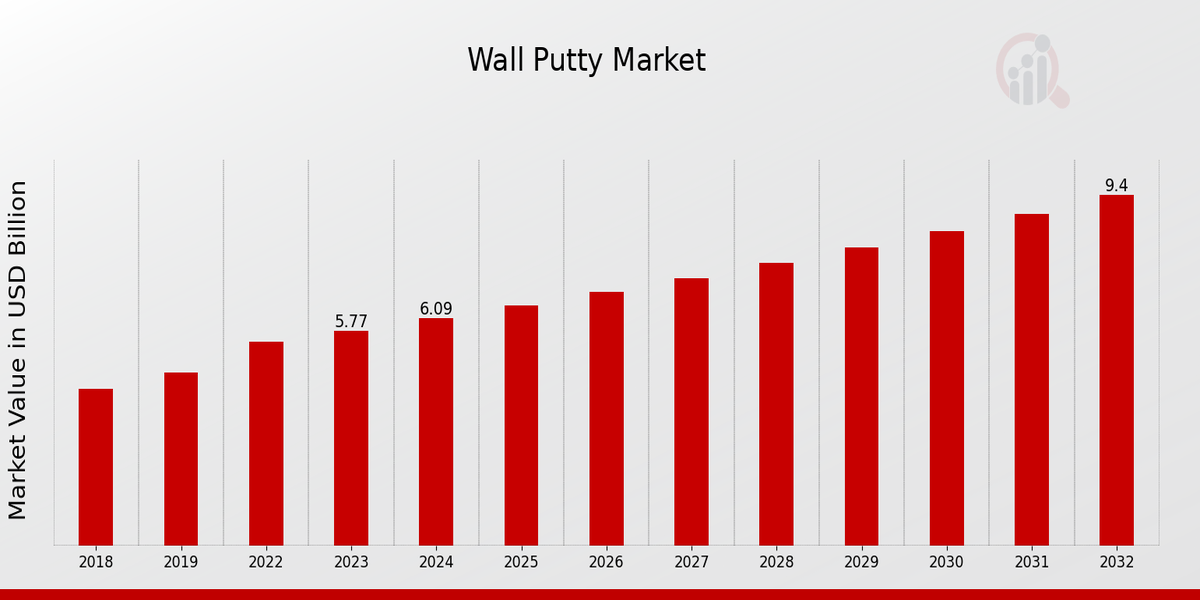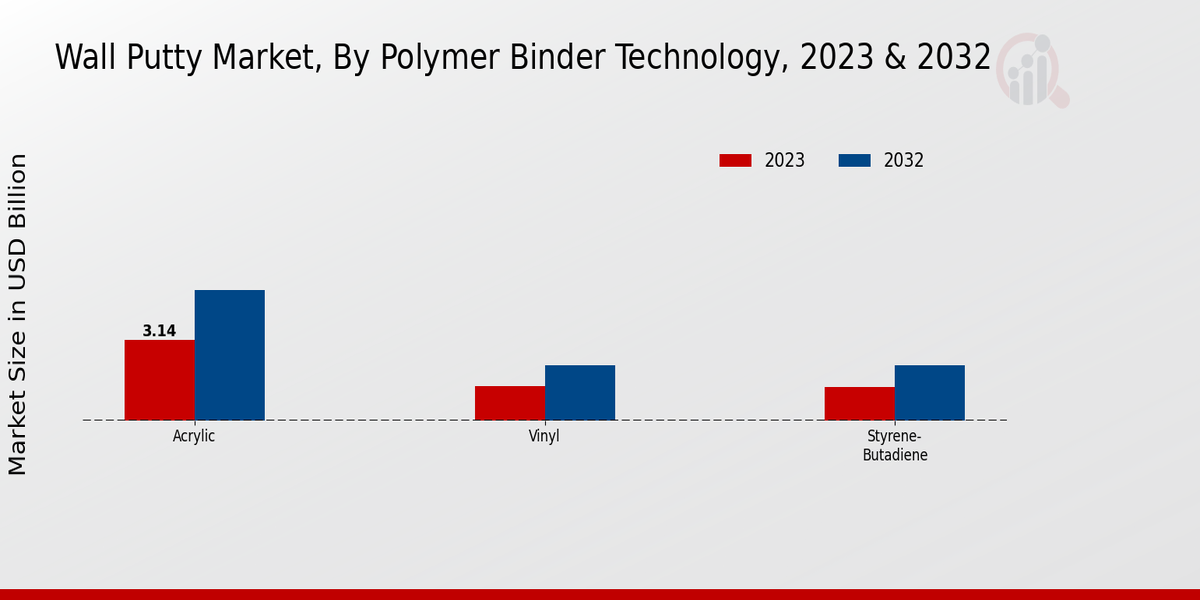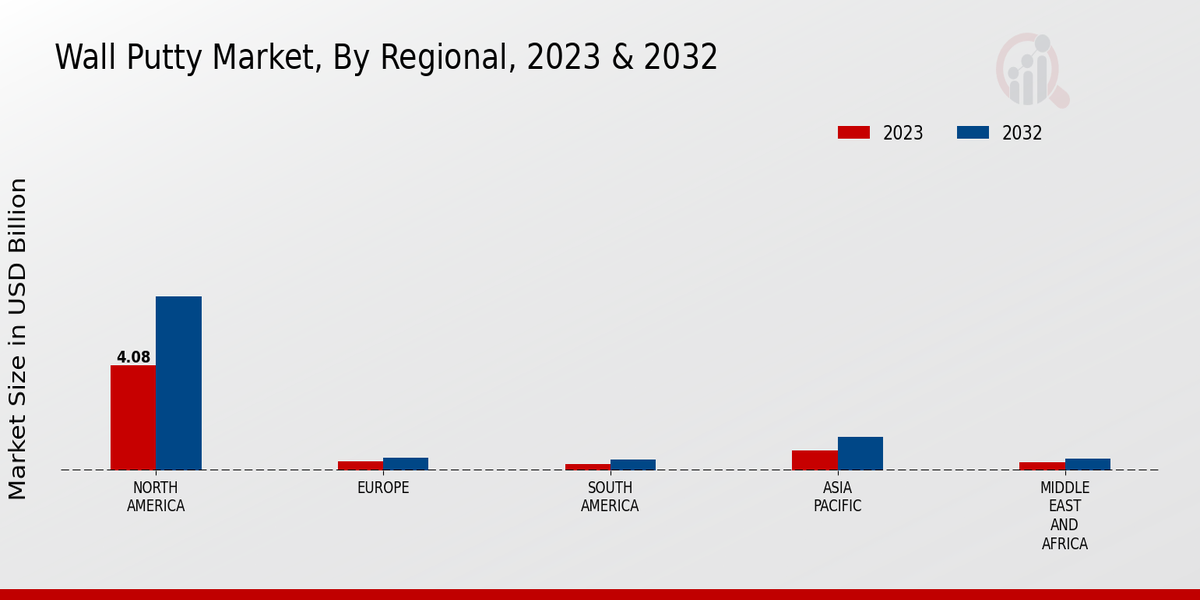Global Wall Putty Market Overview
The Wall Putty Market Size was estimated at 5.47 (USD Billion) in 2022.The Wall Putty Industry is expected to grow from 5.77(USD Billion) in 2023 to 9.4 (USD Billion) by 2032. The Wall Putty Market CAGR (growth rate) is expected to be around 5.56% during the forecast period (2024 - 2032).
Key Wall Putty Market Trends Highlighted
The wall putty market is anticipated to witness significant growth due to increasing demand for aesthetically appealing and durable interior wall finishes. Key market drivers include the rising construction industry, urbanization, and home renovation activities globally. Opportunities for market expansion lie in penetrating emerging markets, developing innovative products with enhanced performance, and focusing on sustainable and eco-friendly solutions to cater to consumer preferences.Recent trends in the wall putty market indicate a shift toward fortified, water-resistant, and ready-to-use products. As consumers prioritize convenience and efficiency, demand for user-friendly and low-maintenance wall putties is increasing. Additionally, the growing popularity of sophisticated architectural designs has spurred the introduction of specialized putties tailored to specific wall textures and finishes. These advancements enhance the overall aesthetics of interiors, driving the market's expansion.

Source: Primary Research, Secondary Research, MRFR Database and Analyst Review
Wall Putty Market Drivers
Rising Demand for Wall Putty in the Construction Industry
The most prominent driver of the Wall Putty Market Industry is the growing demand for wall putty in the construction sector. Wall putty is the most essential material that gets utilized in smoothing and leveling interior and exterior walls by putting them in seamless conditions and making them fit for painting or any other surfacing finish. The construction industry is booming with the increase in inclination towards new as well as renovation of existing household properties and the same is no different in developing countries.Moreover, the demand is also fueled by the rapid pace of urbanization and increase in population, which in turn is exciting the growth chart of housing and commercial construction. All these construction activities in the Wall Putty Market Industry directly contribute in inflating the demand for wall putty as it is widely put to use in all sorts of finish in both interior as well as exterior walls. In addition to this, on the back of the demand of wall putty, there is also presence of substantial demand on the account of various government schemes and plans to formulate affordable housing and development in infrastructure.
Growing Adoption of Gypsum-Based Wall Putty
The Wall Putty Market Industry is witnessing a growing adoption of gypsum-based wall putty. Gypsum-based wall putty offers several advantages over traditional cement-based putty, including its lightweight nature, better adhesion, and increased durability. Gypsum-based wall putty is also more environmentally friendly, as it does not contain harmful chemicals or solvents. As a result, gypsum-based wall putty is becoming increasingly popular among builders and contractors, leading to its wider adoption in the Wall Putty Market Industry.
Increasing Awareness of Wall Putty Benefits
The Wall Putty Market Industry is benefiting from the increasing awareness of the advantages of using wall putty. Wall putty provides a smooth and even surface for painting, reduces paint consumption, and enhances the overall aesthetic appeal of the walls. Furthermore, wall putty acts as a protective layer, safeguarding walls from moisture, cracks, and other damage. As homeowners and building professionals become more aware of these benefits, the demand for wall putty is expected to continue to grow in the Wall Putty Market Industry.
Wall Putty Market Segment Insights:
Wall Putty Market Polymer Binder Technology Insights
Polymer Binder Technology Segment Insights and Overview Polymer binder technology plays a crucial role in the formulation of wall putty. Acrylic, vinyl, and styrene-butadiene are the three primary polymer binders used in the industry. Each binder type imparts unique properties to the wall putty, influencing its performance and application. Acrylic: Acrylic polymer binders are widely employed in wall putty due to their exceptional adhesion, flexibility, and resistance to water and chemicals. They provide a smooth, durable finish, making them suitable for both interior and exterior applications.Acrylic-based wall putties are known for their ease of application, quick drying time, and ability to fill cracks and imperfections effectively. Vinyl: Vinyl polymer binders offer excellent flexibility and water resistance, making them ideal for use in high-moisture areas such as bathrooms and kitchens. Vinyl-based wall putties provide a tough, long-lasting finish that can withstand wear and tear. They are commonly used in commercial and industrial settings due to their durability and cost-effectiveness. Styrene-Butadiene: Styrene-butadiene polymer binders combine the properties of both acrylic and vinyl binders.They offer good adhesion, flexibility, and water resistance, making them suitable for a wide range of applications. Styrene-butadiene-based wall putties are particularly effective in filling large cracks and gaps, providing a strong and stable base for subsequent coatings. The Wall Putty Market revenue is projected to reach USD 6.34 billion by 2024, expanding at a CAGR of 5.8%. The increasing demand for wall putty in the construction industry, particularly in emerging economies, is driving market growth. The rising popularity of premium and specialty wall putties, such as those with anti-bacterial and anti-fungal properties, is also contributing to market expansion.

Source: Primary Research, Secondary Research, MRFR Database and Analyst Review
Wall Putty Market Polymer Binder Technology Insights
The Finish Type segment plays a crucial role in the Wall Putty Market, influencing market growth and consumer preferences. Matt finish, with its non-reflective and smooth surface, accounts for a significant share of the market revenue. It is widely used in residential and commercial buildings, offering a sophisticated and understated look. Gloss finish, on the other hand, provides a shiny and reflective surface, making it suitable for areas that require a touch of elegance and glamour. Semi-Gloss finish offers a balance between Matt and Gloss, combining durability with a subtle sheen, making it popular in high-traffic areas and kitchens.The Wall Putty Market data indicates a growing demand for Semi-Gloss finish, owing to its versatility and aesthetic appeal.
Wall Putty Market Application Type Insights
The Wall Putty Market is segmented by Application Type into Interior and Exterior. The Interior segment is expected to hold a larger market share due to increasing construction activities and renovation projects. The Exterior segment is also witnessing significant growth owing to the rising demand for weather-resistant and durable wall finishes. In 2023, the Wall Putty Market for Interior applications was valued at USD 3.24 billion and is projected to reach USD 5.12 billion by 2032, exhibiting a CAGR of 5.8%. The Exterior segment is anticipated to grow from USD 2.53 billion in 2023 to USD 4.28 billion by 2032, registering a CAGR of 5.3%.
Wall Putty Market Surface Type Insights
The Wall Putty Market segmentation by Surface Type includes Cementitious, Gypsum, and Wood. In 2023, the Cementitious segment dominated the market with a revenue share of around 55%, owing to its wide usage in both residential and commercial construction due to its durability and affordability. Gypsum is expected to witness a significant growth rate during the forecast period, primarily driven by its increasing adoption in interior wall applications due to its smooth finish and soundproofing properties. The Wood segment is expected to hold a steady market share, with applications in wooden furniture and decorative elements.
Wall Putty Market End Use Insights
The Wall Putty Market is segmented by End Use into Residential, Commercial, and Industrial. Among these segments, the Residential segment holds the largest market share and is expected to continue its dominance throughout the forecast period. The growth of the Residential segment can be attributed to the increasing demand for wall putty in residential construction and renovation projects. The Commercial segment is also expected to witness significant growth, owing to the rising number of commercial construction projects globally. The Industrial segment is expected to grow at a steady pace, driven by the demand for wall putty in industrial applications such as warehouses and factories.In 2023, the Wall Putty Market for Residential segment was valued at USD 3.2 billion and is projected to reach USD 5.4 billion by 2032, exhibiting a CAGR of 6.2% during the forecast period.
Wall Putty Market Regional Insights
The Wall Putty Market is segmented by region into North America, Europe, APAC, South America, and MEA. North America is the largest regional segment, accounting for over 30% of the global market revenue in 2023. The region is expected to maintain its dominance over the forecast period, driven by the increasing demand for wall putty in the construction industry. Europe is the second largest regional segment, accounting for over 25% of the global market revenue in 2023. The region is expected to witness steady growth over the forecast period, supported by the growing construction activities in the region.APAC is the fastest growing regional segment, with a CAGR of over 6% during the forecast period. The region is expected to benefit from the increasing urbanization and infrastructure development in countries such as China and India. South America is a relatively small regional segment, accounting for over 10% of the global market revenue in 2023. The region is expected to witness moderate growth over the forecast period, supported by the increasing construction activities in the region. MEA is the smallest regional segment, accounting for over 5% of the global market revenue in 2023.The region is expected to witness steady growth over the forecast period, driven by the increasing construction activities in the region.

Source: Primary Research, Secondary Research, MRFR Database and Analyst Review
Wall Putty Market Key Players And Competitive Insights:
Major players in Wall Putty Market are constantly striving to gain a competitive edge by introducing innovative products and expanding their distribution channels. Leading Wall Putty Market players are investing heavily in research and development to enhance the quality and performance of their products. The Wall Putty Market industry is characterized by intense competition, with key players adopting various strategies such as mergers and acquisitions, partnerships, and collaborations to strengthen their market position. Market participants are focusing on expanding their presence in emerging markets and developing new products to cater to the evolving needs of customers. The Wall Putty Market competitive landscape is expected to remain dynamic, with new entrants and established players continuously vying for market share.Berger Paints India Limited, a leading player in the Wall Putty Market, has a strong presence in India and other international markets. The company offers a wide range of wall putty products, including both exterior and interior grades. Berger Paints India Limited has a well-established distribution network and a strong brand reputation, which has contributed to its success in the market. The company has a dedicated research and development team that is focused on developing innovative products and improving the quality of its offerings. Berger Paints India Limited is committed to providing its customers with high-performance wall putty products that meet their specific needs.Asian Paints Limited, another major player in the Wall Putty Market, is known for its extensive product portfolio and strong brand recognition. The company offers a variety of wall putty products, including putty for interior and exterior applications, as well as putty for specific purposes such as filling cracks and repairing surfaces. Asian Paints Limited has a wide distribution network and a strong presence in both urban and rural markets. The company has a dedicated research and development team that is focused on developing innovative products and improving the quality of its offerings. Asian Paints Limited is committed to providing its customers with high-performance wall putty products that meet their specific needs.
Key Companies in the Wall Putty Market Include:
- Akzo Nobel
- SaintGobain
- Henkel
- Pidilite Industries
- Berger Paints
- BASF
- RPM International
- SherwinWilliams
- Nippon Paint
- Mapei SpA
- Asian Paints
- Wacker Group
- Kansai Paint
- Sika AG
- PPG Industries
Wall Putty Market Industry Developments
Wall Putty is a paste-like material applied to interior and exterior walls to smooth out imperfections and provide a base for paint or wallpaper. As the construction industry rebounds post-pandemic, the Wall Putty Market is anticipated to grow steadily from its 2023 valuation of USD 5.77 billion to reach USD 9.4 billion by 2032, exhibiting a CAGR of 5.56%.Recent Developments Increasing Demand for Eco-Friendly Products: Consumers are becoming more environmentally conscious, driving demand for wall putties with low VOC emissions and sustainable ingredients. Expansion into Emerging Markets: Developing countries in Asia-Pacific and Africa are witnessing significant growth in construction activities, creating opportunities for wall putty manufacturers. Technological Advancements: Innovations such as self-leveling and quick-drying wall putties are improving application efficiency and reducing labor costs.Current Affairs Impact of Supply Chain Disruptions: The ongoing global supply chain issues have affected the availability and pricing of raw materials used in wall putty production. Rising Labor Costs: The construction industry is facing labor shortages and rising wages, potentially impacting the cost of wall putty application. Government Initiatives: Governments worldwide are implementing regulations to promote energy efficiency in buildings, which is expected to boost demand for wall putties with insulating properties.
- Wall Putty Market Polymer Binder Technology Outlook
- Acrylic
- Vinyl
- Styrene-Butadiene
- Wall Putty Market Finish Type Outlook
- Wall Putty Market Application Type Outlook
- Wall Putty Market Surface Type Outlook
- Wall Putty Market End Use Outlook
- Residential
- Commercial
- Industrial
| Report Attribute/Metric |
Details |
| Market Size 2022 |
5.47(USD Billion) |
| Market Size 2023 |
5.77(USD Billion) |
| Market Size 2032 |
9.4(USD Billion) |
| Compound Annual Growth Rate (CAGR) |
5.56% (2024 - 2032) |
| Report Coverage |
Revenue Forecast, Competitive Landscape, Growth Factors, and Trends |
| Base Year |
2023 |
| Market Forecast Period |
2024 - 2032 |
| Historical Data |
2019 - 2023 |
| Market Forecast Units |
USD Billion |
| Key Companies Profiled |
Akzo Nobel ,SaintGobain ,Henkel ,Pidilite Industries ,Berger Paints ,BASF ,RPM International ,SherwinWilliams ,Nippon Paint ,Mapei SpA ,Asian Paints ,Wacker Group ,Kansai Paint ,Sika AG ,PPG Industries |
| Segments Covered |
Polymer Binder Technology ,Finish Type ,Application Type ,Surface Type ,End Use ,Regional |
| Key Market Opportunities |
Expansion into developing regions Rising demand for ecofriendly products Growing construction industry Increasing home renovation activities Technological advancements |
| Key Market Dynamics |
Rising construction activity Increasing urbanization Growing disposable income Government support for infrastructure projects Technological advancements |
| Countries Covered |
North America, Europe, APAC, South America, MEA |
Frequently Asked Questions (FAQ) :
The Wall Putty Market was valued at USD 5.77 billion in 2023 and is expected to reach USD 9.4 billion by 2032, exhibiting a CAGR of 5.56% during the forecast period.
Asia Pacific is expected to dominate the Wall Putty Market, accounting for the largest market share. The growth in this region is attributed to the increasing construction activities in developing countries such as China, India, and Indonesia.
Wall Putty finds applications in various sectors, including residential, commercial, and industrial buildings. It is primarily used for smoothing and leveling interior and exterior walls, ceilings, and other surfaces before painting or wallpapering.
Some of the prominent players operating in the Wall Putty Market include Asian Paints, Kansai Nerolac Paints, Berger Paints, AkzoNobel, Jotun, Nippon Paint, PPG Industries, Sherwin-Williams, Valspar, and RPM International.
The growth of the Wall Putty Market is attributed to factors such as increasing urbanization, rising disposable income, and growing demand for aesthetic appeal in buildings. Additionally, government initiatives promoting affordable housing and infrastructure development further contribute to market growth.
The Wall Putty Market faces challenges such as the volatility of raw material prices, environmental regulations, and intense competition from local and regional players. Economic downturns and fluctuations in the construction industry can also impact market growth.
Key trends in the Wall Putty Market include the adoption of sustainable and eco-friendly products, advancements in application technologies, and the growing popularity of textured and decorative wall finishes.
The COVID-19 pandemic had a moderate impact on the Wall Putty Market. While construction activities were temporarily disrupted during lockdowns, the market witnessed a recovery as construction resumed and demand for home renovations increased.
The future of the Wall Putty Market looks promising. Growing urbanization, increasing disposable income, and the rising demand for aesthetically pleasing buildings are expected to drive market growth in the coming years.
The Wall Putty Market is subject to various regulatory frameworks related to product safety, environmental protection, and consumer rights. These regulations vary by country and region, and manufacturers must comply with the applicable standards to ensure the quality and safety of their products.





























